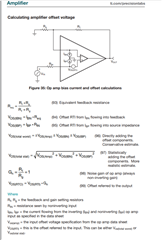Tool/software:
Hi,
This is related to my previous thread on OPA211-HT
I have the following questions:
1. Since Ios at 210 C is 150 nA(max) and I am using this op amp at 210C, with gain of about 700, should I be concerned about the effect of Ios on my output ?
2. I know Vos drift is 2uV/C, but what is the drift of Ios -- are the drifts linear up to 210C ?
Thank you



